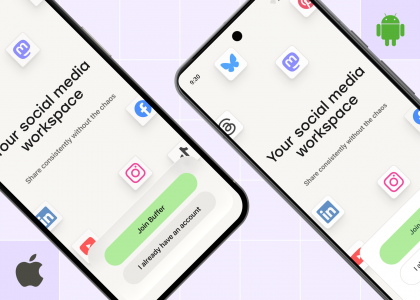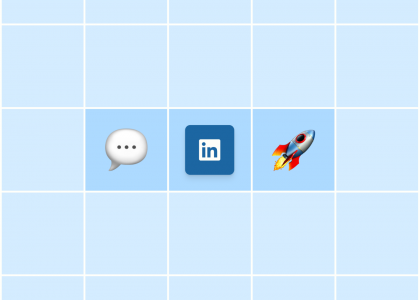BFCM — Black Friday and Cyber Monday — is an exhilarating but often daunting time of year for business owners and marketers.
Now that fantastic deals are table stakes, it can feel like shouting into a crowded room to ensure your brand gets the attention it deserves. But capturing market attention is well worth doing over this high-spend period. According to the National Retail Federation, we’re looking at a record-breaking November and December this year, with total sales reaching a staggering $966.6 billion in the U.S.
To help you stand out from the crowd, here’s some guidance — complete with tried-and-tested examples. In this article, you’ll find a host of tips, tricks, and tactics that can help you boost your already-planned Black Friday and Cyber Monday campaigns.
If you haven’t started getting your marketing plan together, there’s still time — Black Friday in 2023 is on November 24th, and Cyber Monday, the 27th.
Happy BGCM planning!
1. Partner with media brands
Take it from a former lifestyle journalist — Black Friday was also wild in media. Many online publications take advantage of affiliate sales links with product recommendations and round-ups.
Brands like Women’s Health, Cosmopolitan, and Good Housekeeping started rolling out their Black Friday content weeks ago. They will undoubtedly have several writers exclusively focused on new reviews and round-ups on the day.
Reach out to publications within your niche, particularly if you can offer a commission on sales for customers via their website.
Getting your brand featured on their site is hugely beneficial beyond just the additional eyeballs. As anyone in content marketing will know, backlinks on a high-authority site do wonders for your SEO (search engine optimization). You’ll also be building relationships with journalists in your niche, so your brand is top of mind when an article you might be a fit for comes up. It’s a win-win.
2. Showcase your brand values
For many people, the over-the-top consumerism of Black Friday and Cyber Monday can be a little jarring. Consider if that might apply to customers in your target audience — would launching a high-stakes Black Friday campaign erode trust with your long-time buyers?
Outdoor apparel retailer REI has led the charge here, opting out of Black Friday for years on the trot. They even closed their stores and sent their employees home. Their goal was for their customers to feel empowered to skip Black Friday and #OptOutside.
Patagonia is another brand at the forefront of this movement. In 2011, they took out a full-page ad in the New York Times emblazoned with the headline, “Don’t buy this jacket.” The initiative was part of their ongoing Common Threads initiative, which aims “to address the issue of consumerism and do it head on.”
@patagonia‘s ‘dont buy this jacket’ campaign integrated their #ecofriendly core values into their marketing- they believe in #sustainability, encouraging consumers to support their thread-up intiative and reduce their waste. #uwamktg6 pic.twitter.com/ykwwVBX3XR
— Charlotte Gibbs (@Charlottemg2000) March 22, 2021
Lush has also used Black Friday to show off their brand values, albeit slightly differently. Over Black Friday weekend in 2017, the UK-based luxe skincare brand launched 14,600 special edition orangutan soaps at £8.25 each, with 100 percent of proceeds going to the Sumatran Orangutan Society (SOS). The soaps sold out within hours.
In 2020, sustainable footwear brand Allbirds did something similar by raising their prices by $1 across the board. All the proceeds went to Fridays For Future, the youth-led international climate movement founded by climate activist Greta Thunberg.
“Black Friday deals may satiate momentary desire, but their impact on the planet is a lot more long-lasting,” said the company in a release. “That’s why Allbirds wanted to do things a bit differently this year, flipping tradition and doubling down on our commitment to sustainability.”
3. Stand out from your other sales
If Black Friday is your biggest sale day of the year, why not go all-in? Cult skincare brand Glossier does this brilliantly by having only one website sale yearly — around Black Friday.
The fact that this is the only time make-up lovers can nab their favorite products at a discounted rate makes the sale a newsworthy event in and of itself. Widely followed publications like Teen Vogue and Cosmopolitan started covering the Glossier sale back in September, speculating about what would be discounted and what products they hoped to nab.
4. Make your sale invite-only
For certain target markets, exclusivity makes sense. You could use Black Friday to make your most-valued customers feel special rather than just another beep on the proverbial cash register.
A great way to do this is to send out invites or special discount codes to certain segments of your audience. Amazon is the most obvious example of this with their invite-only sales, where customers effectively have to opt in for specific products on big sale events like Prime Day.
While leveraging your current subscriber or mailing list in this way is a great option, you could use the opportunity to forge deeper connections with a smaller group of valued customers. Try pinpointing your most engaged newsletter subscribers or social media followers, or most frequent customers and then reaching out with a more personalized message and discount code.
Sure, it might involve a little extra leg work, but a personal touch goes a long way when it comes to building trust with valued customers.
5. Go anti-black Friday
As is the case with REI and Lush, it’s not uncommon to see businesses advertising how they’re not going to jump into the seemingly money-grabbing fray. If it makes sense for your brand, you could also take a stand against the Black Friday frenzy — but in a more tongue-in-cheek way.
Cards Against Humanity has gained notoriety for going all in on this tactic multiple times over the years in increasingly clever ways. That includes increasing the price of a deck of cards in a “once-in-a-lifetime” deal and a wild 99 percent off sale on an array of random items. One customer apparently nabbed a Ford Fiesta car for under $100.
Un-ignorable marketing idea from: @CAH
In 2021, Cards Against Humanity didn’t offer any Black Friday deals
They actually raised their price by $5!
The move generated a ton of buzz
The result? They sold MORE games than the previous year—genius, right? pic.twitter.com/fStgftcBJE
— Katelyn Bourgoin 🧠 (@KateBour) November 19, 2022
In 2015, they made headlines for charging customers $5 for… absolutely nothing. Astoundingly, it worked. The company reportedly made over $70,000. Of course, having a cult-like following of customers who delight in the bizarre certainly helps.
6. Leverage user-generated content (UGC)
You probably have a lot of content to create around these busy holiday dates, so it can be quite a relief to get some user-generated content (UGC) from your community by re-sharing the content that they’re already making.
This could take a lot of different forms, like photos of your brand and product or positive user reviews. It’s especially easy on Instagram Stories, where you can reshare someone else’s post to your Stories with just a couple of taps.
Some companies go the extra mile and create programs to incentivize users to create and share content about the brand, particularly around big sale events. You can tie giveaways into this strategy — offer prizes to random winners who have used a certain hashtag or commented on a post.
Here are some more examples:
Ask your community to share a photo of their must-nab product in the saleAsk followers to vote on which item they want to see on sale on BFCMEncourage them to share a snap of them with their Black Friday purchase
7. Live shopping
There is so much untapped potential for social media lives when it comes to Black Friday and Cyber Monday. All the major social platforms offer some sort of live streaming features (here’s our full guide to Instagram Lives), which could be used in a plethora of ways to build hype, share deals, and gain traction online. Some options could include:
Live vox pops in store with customers (with their permission, of course)A live unveiling of the biggest Black Friday or Cyber Monday deals in the run-up to the dayA live event with exclusive discount codes for the attendees
MeUndies is often cited as the brand that pioneered the latter with its Black Friday Drawer Buster Event. “Skip the stores on Friday and watch us live for secret promotions only being offered to you, our MeUndies Fans,” they teased in the event promo. “We’re giving the best deals you have ever seen from MeUndies.”
The event (which even featured a live DJ) didn’t disappoint. As more and more people joined, they unveiled bigger and bigger deals. According to this report from Shopify, over 13,000 people tuned it, with attendees converted at a rate of 25 percent — that’s 13 times the average conversion rate MeUndies sees on Facebook.
Source: Facebook
8. Make a ‘mistake’
The tweet below might seem like every social media manager’s worst nightmare — but it may have been part of a clever Black Friday attention-grabbing tactic by McDonald’s all along.
Black Friday **** Need copy and link****
— McDonald’s Corporation (@McDonaldsCorp) November 24, 2017
I’m inclined to think so — the fact that the tweet still exists (and was quickly followed up with a clever response) seems to indicate it was planned. Regardless, the seemingly innocuous mistake garnered 1.1K responses, 21K retweets, and over 60K likes.
The play wasn’t attached to any kind of special deal, discount, or sale, but, as one commenter put it, “It’s genius. It’s Black Friday and everyone is talking about them now. Coffee to fuel their shopping habits!”
If your social media tone of voice is not quite as cheeky as McDonald’s, you could adopt a tactic more along the lines of the ‘marketing intern’ email sent to Brooklinen’s entire subscriber list, which was supposedly only meant to go to their superiors for checking.
Source: Architectural Digest
After some speculation, the linen brand confirmed it was planned. “We wanted to surprise our customers (and the people who have supported us over the years) by making Black Friday accessible for a full week!” a spokesperson said.
They also reassured those worried about the intern in question, Mark. “We also wanted to pay homage to the Mark in all of us, for all the accidental emails we’ve sent over the years!”
9. Think ahead for and beyond BFCM
The Black Friday weekend is almost a four-day affair, if not more. There’s Gray Thursday, which is U.S. Thanksgiving Day, then there’s Black Friday, Small Business Saturday, and Cyber Monday, which some companies extend for the whole next week.
If you’re thinking of using multiple days for your marketing plans, consider some of the unique behaviors of your audience on these days. For instance, on Black Friday, you might tie some of your marketing into some Buy Online/Pickup In Store specials (commonly referred to as BOPIS), and on Cyber Monday, offer special discounts for online customers exclusively.
It’s worth getting ahead of the curve, too. Around 43 percent of consumers start their holiday shopping before November, the NRF reports. There are several reasons for this, including spreading out their budget (60 percent), avoiding the stress of last-minute shopping (46 percent), and avoiding crowds (45 percent). Consider the behavior of these buyers when launching your BFCM campaigns, too — many will be happy to nab a good deal ahead of the stress of November 24th.
If you haven’t yet finalized your Black Friday or Cyber Monday plan yet, fear not. The higher-spend time will, of course, continue well into the festive season. The NRF also found that the majority of shoppers (62 percent) expect they won’t finish until December — so there’s plenty of time for that groundbreaking marketing campaign.
Do you have a genius Black Friday or Cyber Monday campaign you think is worthy of this list? We’d love to hear about it! Message @buffer on X (Twitter), LinkedIn, or Instagram to get in touch.






